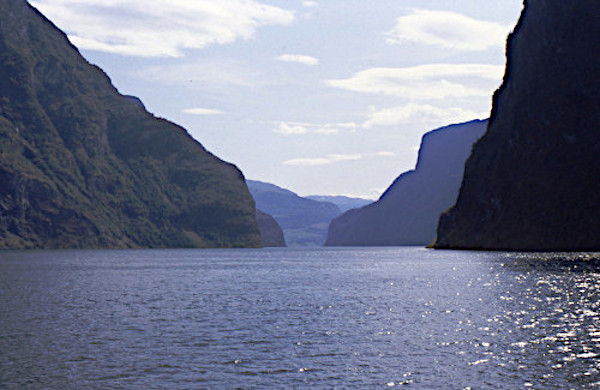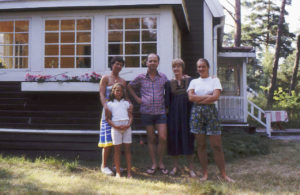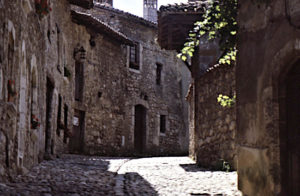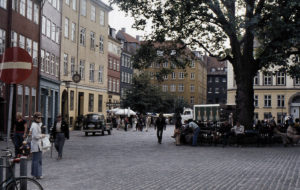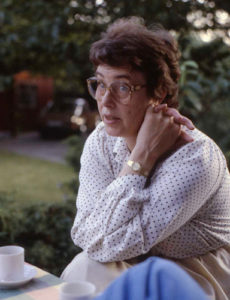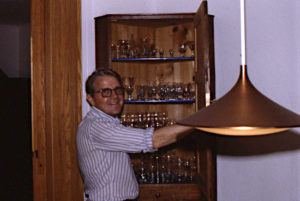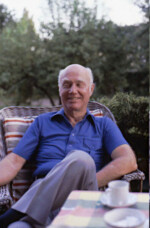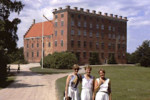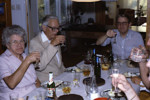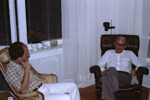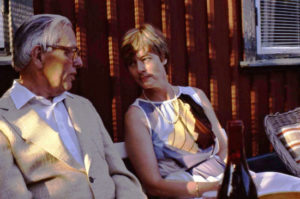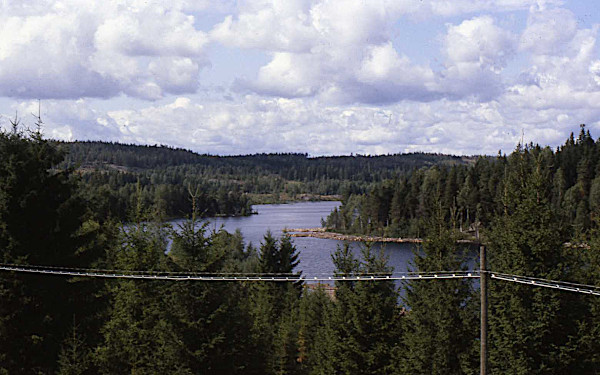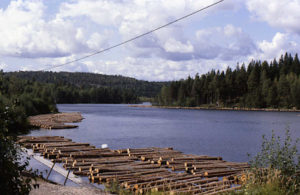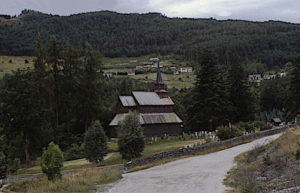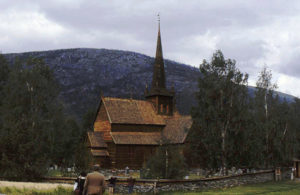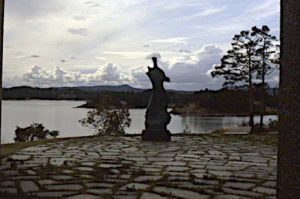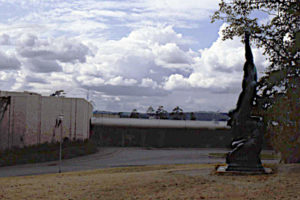Chapter 29 — The big visit to Scandinavia
(Click on photos for larger size)
Margaret’s and Bert’s first visit to Sweden and to Scandinavia in 1982 was a great success. For my parents-in-law the trip with us started in Copenhagen after a flight from Amsterdam where a blackguard stole Bert’s high-quality camera. John immediately let him have his ‘back-up’ camera, much less perfect, but at least Bert had a camera. Damn airport thieves. But before we get to Margaret and Bert, there is another story.
We had come up a couple of days earlier, driving our Renault 20 (no rattling Renault 4L any more, but gee that little rattler really took us places.) from Paris through Germany and to Travemünde, where we took a ferry to Trelleborg. We stopped at a German pretty little town that we don’t remember the name of. There are so many of those cute little towns in Germany with a nice market Platz in the center with old-style buildings . We arrived in Trelleborg in the morning after a night onboard the ferry — tiny put very comfortable cabins with a shower. We drove straight west the short distance to Höllviken, a summer resort on the south coast of Skåne, to the house of our friends, Britt and Ingvar. I had been there innumerable times, even in my early youth when the house belonged to Britt’s parents — whom I knew very well — as
well as her three sisters. But we certainly had a hard time finding the house, even though I had the address. Finally, when I asked for the Norrmans’ house, we got there right.
The house has been modernized, but it was always very nice and sitting on a sizeable lot surrounded by pines and more pines, which is typical for Höllviken. Pines and sandy soil all the way down to the beach and the dunes, where you have to wade out quite a bit to even be able to swim. A paradise for families with small children.
So now, before we went to join John’s parents for a day in the wonderful Danish capital, we got to spend a day with these very dear friends from my youth. Katarina, the oldest daughter, was, a couple of years later, going to become one of our Swedish girls in Paris. She would have been 19 at this time and little Lotta about 7. I had seen Katarina as a toddler in 1964 the year I left for the United States. Helena was not present this time around, so she was probably spending some time with a friend, the way you love to do in your mid-teens. We have also made numerous visits to Britt’s and Ingvar’s wonderful house in Täby, a northern upper-class suburb of Stockholm — at least a couple of Christmases, one crayfish party that John will never forget about — and neither will Ingvar — and yet more visits.
They have also visited us here in Genas a couple of times. Once it was just Britt and Lotta, and I have pictures of us in Pérouges, a medieval walled town northeast of Genas, all cobblestones and nothing but medieval houses. A beautiful old town.
We also visited Vieux Lyon of course, where I was a lot less perfect as a guide than John always is. But I also remember well how Ingvar, on a different visit, weeded our bush ‘massif‘ with just the right tool, so he wouldn’t have to kneel or bend over too much. He actually liked the work. And so did we. His work.
After this brief visit to Höllviken, we traveled to Copenhagen with the car, by ferry from Limhamn, also just south of Malmö, to spend a day with Margaret and Bert before taking the ferry back to Malmö. The bridge[1. Øresund Bridge — The Øresund Bridge is the longest combined road and rail bridge in Europe and connects two major metropolitan areas: Copenhagen, the Danish capital city, and the Swedish city of Malmö. It connects the road and rail networks of the Scandinavian Peninsula with those of Central and Western Europe.] was far away in the future at the time, being opened only in July 2000.
This visit to Scandinavia with my parents-in-law got to be a very involved one, and it must have lasted several weeks, if not a month, with Norway, Oslo, the mountains and the fjords.
Now, once with Margaret and Bert in Copenhagen, we visited the downtown of course, Rådhuspladsen, walking up to Runde torn and up into Runde torn for the first time in my life. This flat-topped round tower we could see so well on a clear day from our balcony in Malmö on Limhamnsvägen — along with all the other towers in Copenhagen that we got to recognize quite well. It got to be a game with my family, recognizing the multiple towers on the Copenhagen skyline. Arne was the best one at that game.
After Runde torn we walked over to one of our favorite spots in Copenhagen, Gråbrødretorv, where we had lunch at Scott’s restaurant, which doesn’t seem to exist any more. Sad. We loved it. And I believe that we always had their delicious deep-fried plaice with pommes frites.
______________________
Now we are in Sweden and, more exactly, in Lund, where Gun and Per were the most wonderful hosts. Per was superb, always being attentive to Margaret, which she clearly appreciated greatly. And so did we. And Gun was a wonderful hostess for all of us. Only Arne was, as was his wont, superbly absent-minded and ignoring polite
conversation with John’s parents, on the day he and Maja were with us. He spent that last entire evening after dinner talking to John. Maja was our friend from way back and now a widow and Arne’s social companion after Mother died. Maja luckily made up for Arne’s lack of politeness to some extent, and John’s parents said pointedly afterwards that Maja was very nice. For one thing Maja’s Enbglish was certainly better than Arne’s, and I do think that he might well have been feeling awkward about small-talking in English. Well, Arne was always a spoiled child into his late seventies. He knew John very well and he knew they could communicate on matters that were of interest to both of them.
Gun’s dinner was wonderful, and everybody was in the very best mood. But in a way, Bert’s taking us all, the three children obviously very much included, to a fabulous dinner at Svaneholms slott — Svaneholm Castle — was after all the high point of the three days in Lund. The food was wonderful, the ambiance in this restaurant in an old castle was old Swedish. Perfect for our American friends. The interior has been kept
from days long gone, and all of this contributed well to this very special and festive occasion. My family were meeting with John’s under the most festive and happy circumstances. We even had snaps. Since we were now In Sweden, we thought snaps was de rigueur. Margaret and Bert went along with this Viking-like Scandinavian custom, and we all said Skål.
This excursion to skånsk countryside also included walking around in the pastoral grounds around the castle and having a look at the nearby, very beautiful and typically skånsk church, Sövde kyrka and walking around in the wonderful surroundings in the vicinity of the castle.
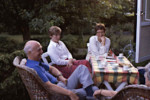
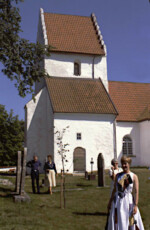
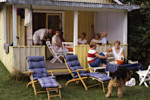

It was an unforgettable couple of days and Gun and Per were the most wonderful hosts imaginable. Kajsa also lent my parents-in-law her two-room apartment a block away from Klövervägen where Gun and Per lived.
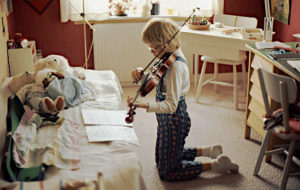
Sara, 9 years earlier playing the violin in her light-colored beautiful room. She was ten at the time. (1973)
Måns was a medical student and he had moved into a student dormitory. Those are usually hard to come by, but he had managed. John and I went to see his ‘digs’ and, wow! He had his own stereo hi-fi system. We listened to a Bach organ concerto and we loved it. This was indeed very different from the way I lived during mu student days in Lund.
Sara was the one ‘child’ who was still living at home, in her beautiful very light-colored room downstairs. That was the room where she had played the violin for us in 1973 on John’s second visit to Sweden and his second meeting with my family. John has gotten to be very close to everybody in my family. They are now all of them ‘our’ family.
Per thought we must certainly not forget about ‘Kulturen’, the wonderful outdoor museum behind the cathedral. Tha Agrup children grew up with this wonderful museum and I can remember very clearly how Kajsa when she was 3 or 4 wanted to go to Kulturen to sit on Karl XII’s rocking horse.
ngg_shortcode_0_placeholderI have always loved that museum. You bend over and step into one of the very old little houses, maybe a ‘soldattorp‘, a one-room little house with a thatched roof, or simply grass. You then feel as if you have moved back centuries in time. I guess we
just assumed that Margaret and Bert wanted to see a piece of old European history and we took them on a visit. I do hope they enjoyed it.
____________
After this brief but very happy visit with my family in Lund and Skåne, we drove to Stockholm with Margaret and Bert. The couple of days in the capital were well appreciated, but unfortunately we had a very unusual heat spell with temperatures up to 35°C, which is almost unheard of in Stockholm and even in Skåne in the very south.
One day we took them on a boat ride from Nybroviken, across the street from the Royal Dramatic Theater, up through Djurgårdsbrunnskanalen and to Djurgårdsbrunns värdshus (inn), where we did not stop for dinner. It is actually one of the very best restaurants in Stockholm. Expensive too. However, we did go with Margaret and Bert to another top restaurant, Stallmästaregården, on the northern border of Stockholm. This little boat trip was mainly planned so as to get away from the hot city streets for a while. I hope my parents-in-law appreciated the beautiful view you get of the summer green beauty of Djurgården on this little boat tour. But, frankly, the hot weather and the lack of air-conditioning at their hotel certainly to some extent took away from what I had hoped would be a visit to the most beautiful capital I know. How sad.
_____________________
Margaret and Bert took a guided tour to Uppsala, while John and I went on to visit some very dear old friends. This bus trip to Uppsala, where the oldest Swedish university was founded in 1417, even before Lund University, was also a bit of a disaster, however. The bus did not have air-conditioning and Margaret and Bert were not happy. A tourist bus without A/C would be unthinkable in the U.S.
The friends John and I had gone to visit were indeed very special friends from a very long time ago. Lennart and his new wife, Maria, had a summer house in Löa, in Bergslagen (a former mining area) in the very center of Sweden — that is if you don’t count in Lapland and the very north, which is very sparsely populated.
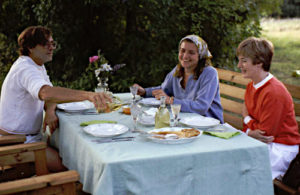
Midday dinner at Lennart’s summer house in Löa with Maria. second wife, a most adorable woman and a wonderful artist.
This had to be a very short visit. It was John’s and my third visit to Löa, at least, after the very first one in 1971. That time, Lennart’s first longtime wife, my old friend Ragnhild, had made gravad lax, which translates very inadequately as ‘marinated salmon’. Gerd and Göran came down from Dalarna, where they have a family country house. Gerd brought their home-grown potatoes, dug up a couple of hours earlier, which are a delicacy all by themselves.
I have also previously written about our longest visit in Löa, which took place in 1984 when we traveled from France in two cars with our old French friends, Jean and Danièle Porta, with son Olivier and also François, the son of other very good friends of ours. (Chapter 21 (Part 2)) –– Bergslagen and Löa 13 years later)
The picture below, taken by John — thus his empty chair — reminds me so much of a painting by Renoir that I just had to go in search of it. I found it — Le Déjeuner des canotiers. And by the way, the hat that Göran is wearing here is called un canotier in French a ‘boater’ in English.
I love this picture certainly partly because of this wonderful hat. But the ambiance in the picture is visible, it seems to me. And also my very special friend Gerd, on the extreme right, is one of the most artistic and wonderful women that ever was. They had, once again, come down to Löa from southern Dalarna, just to see us. What wonderful friends.
__________________
After our little visit to Löa, we joined up again with John’s parents in Örebro to the south. They had come to Örebro by train from Stockholm, and we now drove due west on to Oslo, the Norwegian capital. We traveled on one of the most gorgeous roads in gorgeous Sweden, through the province of Värmland, right north of Lake Vänern, in west-central Sweden.
There was however a little snag in our traveling through the wonderful province of Värmland. We had stopped for lunch in the neighborhood of Karlskoga. We then continued on our way and were stopping at a gas station close to Karlstad, when John discovered that he did not have his purse with his wallet, papers, passport and everything of basic importance for travelers. Fortunately, I remembered the name of the gas station-cafeteria where we had lunch. Now the very friendly people at the same ‘brand’ of gas station called up their colleagues where we had lunch. I talked to a woman and explained that my husband had clearly left his purse on the back of his chair with all the valuables in it. I said “Might you possibly know anything about it?” The woman said “I have it right here in front of me”.
Oh wonderful honest Swedes. I love you all. So back we went, a fair distance, but we were thoroughly relieved after the big shock and we took it in our stride. We gained one thing. On our way back towards Oslo, we saw a majestic moose at some distance, only the second moose I have seen in my life. We did not take a picture of him and I don’t know why not. I remember clearly that we stopped and got out of the car. The first moose I ever saw was on an island in the Stockholm archipelago. That time I stood right next to the huge beast and my head was not quite on a level with his noble head. Moose are excellent swimmers, so it was not really such a surprise to meet one in the archipelago. But in those days, 1960 or so, they did not go as far south as Stockholm.
This unplanned excursion probably added at least one hundred kilometers to our drive to Oslo, but John got his passport and all his papers and money, and nobody complained. It was pretty late when we finally arrived in Oslo. We parked in the underground parking garage of our hotel and we left the map-reading light on.
We did not use our car in Oslo and the day we were leaving we discovered that the battery was dead. Someone helped us start the motor, and we spent a few nervous hours while the battery was getting charged.
We did our sightseeing in this beautiful city on foot or mostly by cab, as I remember. Oslo has more varied museums than any city I can think of. Plus it was not nearly as hot as in Stockholm. Here it was a normal Scandinavian summer.
Our few days in Oslo were filled with visits to extraordinary museums — from the amazing Viking museum to the very pleasant Folk museum, both located on Bygdøy, a peninsula at the northern end of the Oslo fjord.
Oslo is set in the area north-northeast of beautiful Oslo fjord, with several big and small peninsulas and islands. We crossed over the fjord a couple of times to visit the various museums, which are mainly located on Bygdøy peninsula. It is the site of the “Viking museum” (Vikingskiphuset) and also of the “Folk museum” (Norsk Folkemuseum) which can be seen as something like the open-air Skansen museum on Djurgården in Stockholm.
The Viking Museum on Bygdøy was a wonderful surprise. I definitely did not realize how very big those Viking boats were, the boats that reached Constantinople in the east, and in the west they settled not just in Scotland, England and Ireland, but they also went all the way to Newfoundland and, of course, Greenland. In order to transport those ‘Long Ships‘ from one river to another in Russia, or what was then probably called Rusland (if not Moscovy), the way Frans G. Bengtsson describes it in Röde Orm (The Red Snake).
I must also have seen the movie “The Long Ships” from 1964, because I can see, in my inner eye, how they rolled these huge boats on big wooden logs, which were carried from the stern to the bow as the boats progressed, in order to transport these big monsters from one river to the next, traveling south inside Russia. It would have taken a great number of more or less slaves to get that job done.
Röde Orm is the fictitious name of a Viking chief and it is a book I believe most Swedes read, or at least we used to. It has been translated into English under the title ‘The Long Ships‘. It was definitely amazing to see the size of those boats which were rowed or sailed over oceans and rivers to the west and the east.
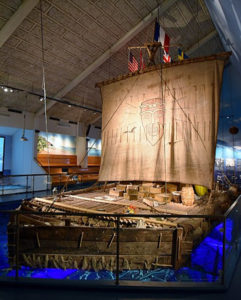
The Kon-Tiki raft at the Kon-Tiki Museum, Oslo. Wikipedia
There is also the Kon-Tiki museum, also on, Bygdøy peninsula, built in honor of the world famous explorer and scientist Thor Heyerdahl, a name that became a part of my life in my early youth. I read his book, “Kon-Tiki” when I was very young.
Thor Heyerdahl made his famous voyage on a balsa raft from Peru to the Easter Islands in the Pacific, one of the most isolated places in the world.
However, the thing he was trying to prove, that the people on the Pacific islands originated from South America, has later been proven to be wrong, by testing the DNA of these peoples. In my youth Kon-Tiki was however the adventure and scientific experiment of our time. Thor Heyerdahl was the hero of that era. (Kon-Tiki expedition)
I find it hard to believe that we didn’t take any pictures at this fabulous museum. I am borrowing a picture from Wikipedia with link to the site on line. I suspect that we were not allowed to take photos, either here or in the Munch museum.
We also went to the great Folk Museum, situated, once again, on Bygdøy peninsula, where you leisurely walk around all these restored houses, transported to this beautiful museum area from all over Norway. There is a stave church that looks very different from anything you can see at the Skansen museum in Stockholm. It’s a completely different style from Seglora church at Skansen. The log houses make me think of the movies based on Vilhelm Moberg’s novels and Jan Troell’s movies, “The Emigrants” and “The Immigrants”, where Max von Sydow builds his own house and Liv Ullman wants to buy flowers and insists on saying ‘blomma’ in Swedish.
With Bert and Margaret we also went to the Munch Museum, even though the strange thing is that we don’t remember any part of the modern architecture that now exists and that also partly existed in 1982 in the ‘old town — Gamle Oslo. But what we do remember is that “Der Schrei” (The Scream), as Edvard Munch himself named a series of several paintings he did on the same motive, a screaming woman on a bridge — “The Scream” was there and we saw it. It was once stolen by masked and armed men, but recuperated by the police.
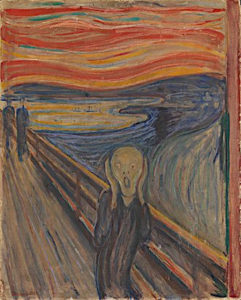
The Scream, der Schrei, by Edvard Munch —Wikipedia
Munch was one of the pioneer expressionists who studied and worked in Germany. So the original name of those paintings was in fact “Der Schrei” and not “Skriet“, which was the translation into Norwegian. Munch seems to have been fairly obsessed by the motive of the Scream, and it is indeed very stark and powerful. Munch is the one expressionist that I can admire, even though I find the most ‘expressionist’ of his works a bit too much for me. We can obviously still be impressed by those skillfully painted works. They certainly are powerful.
Edvard Munch is the one of the expressionists I can claim that I generally like, and in several paintings he seems to be clearly inspired by Vlaminck and Dérain who are considered as fauvistes and who are some of my favorite painters among the post-impressionists.
ngg_shortcode_1_placeholder” order_by=”sortorder” order_direction=”ASC” returns=”included” maximum_entity_count=”500″]Before a dinner in a fancy restaurant in the Old Town, which I had dressed up for, we went to the Vigeland Sculpture Park, which is located a few kilometers northwest of the center of Oslo. Once again we were quite impressed, but I couldn’t help comparing him to our Swedish sculptor from the same era, Carl Milles, whose wonderful museum we had seen on Lidingö in Stockholm. They are very different. Milles has the light flying graceful touch (Chapter 24 (Part 2)) –– Stockholm and some history) and Gustav Vigeland the solid and extremely sensuous style. Clearly those men had two very different personalities. The Sculpture Park was enormously impressive, and the fountain – column ensemble with the fountain surrounded by 20 tree groups is just amazing.
ngg_shortcode_2_placeholder” order_by=”sortorder” order_direction=”ASC” returns=”included” maximum_entity_count=”500″]Margaret and Bert took the train to go on to Bergen. They took a boat from Bergen to see the Sognefjord and saw more of it than we did. Then they flew back home to Florida.
_______________
We all left Oslo on the same day and John and I set out on a tour of the Norwegian high mountains in the center of southern Norway, Jotunheimen National Park. Jotunheimen meaning the home of the Jotun, i.e. trolls or something very similar. Our plan was to climb Galdhöpiggen, Norway’s highest mountain, ‘fjell’ in Norwegian or fjäll in Swedish.
We first drove through beautiful Hardangervidda, a vast wilderness and low-mountain region east of Hardangerfjord, and we saw some stunning scenery.
Our first goal was the town of Voss, and from there we went for a couple of long walks trying to get in shape for Galdhöpiggen. After all our city walking and festive couple of days with our dear friends in Löa and from Dalarna, it was to be proven that we were not in good shape. Farther to the north we reached Gudvangen, where we boarded a ferry that was going to take us through some of the most gorgeous scenery in Scandinavia. There is a lot of it though, but the fjords are very special. Gudvangen is at the south end of Naeröyfjord, an inland fjord that connects to
Sognefjord, where we ended up in Kaupanger, located in a small inlet from Sognefjord — “nicknamed the King of the Fjords. [It] is the largest and deepest fjord in Norway”.(Wikipedia) [1. “The Sognefjord is Norway’s longest and deepest fjord, and its famous arm the Nærøyfjord has World Heritage status. The surrounding mountain areas are amongst Norway’s most popular hiking areas. — Sognefjord“]
We left the ferry in Kaupanger and drove on towards Galdhöpiggen, the highest mountain (fjell) inJotunheimen and in Scandinavia. Leirvassbu was our first goal for an interesting walk to Spiterstulen.
Two days before Galdhöpiggen we made this for us unusual hike over big stones, where you had to skip from one stone to another, water in between, for at least a couple of kilometers, until you got to firm land and an unstable bridge that John hated going over.
Two very impressive glaciers, on either side of the valley we were in, were the most memorable part of this hike. The break-off places in the front were bluish green. It was a wondrous piece of work by Nature.
After a night at Spiterstulen, we got a ride back to Leirvassbu by a friendly man, and we picked up our car to go north on to Juvassnytta, close to Galdhöpiggen, and from where you set out to climb this highest mountain in Scandinavia.
ngg_shortcode_3_placeholder” order_by=”sortorder” order_direction=”ASC” returns=”included” maximum_entity_count=”500″]I was definitely not in good shape as we set out with a group and a guide to get to the top of Galdhöpiggen. I was falling behind the group and John of course kept me company. However, fate helped us out and when the group with the guide in front of us met with an oncoming snowstorm, they turned around and met up with us. We had fallen back because of my bad stamina. So nobody climbed Galdhöpiggen that day, and we didn’t have to feel too bad about it.
One really wonderful part of the hike to Spiterstule was the view of the most fantastic glaciers, bluish green at the front ends, huge and seemingly very stable, even though the greenish color is usually where the ice once broke off and fell into the valley. We had seen quite an impressive glacier one year before at the end of a hike from Montafon Valley in the Austrian Alps, to Saarbrückner Hütte. More about our twenty summers in the Austrian Alps in another chapter.
ngg_shortcode_4_placeholder” order_by=”sortorder” order_direction=”ASC” returns=”included” maximum_entity_count=”500″]After we missed out on the climb up on Gamldhöpiggen, we drove to Lom, with one more beautiful stave church, and from there to the lovely little town of Lillehammer
which is situated alongside two lakes. We were now on our way back to Oslo and to Sweden. The road to Lillemammer takes you up north a bit, since this entire region is strafed by inland fjords, lakes and rivers, before it turns south to Lillehammer and more lakes.
Lillehammer brings to mind Mother’s and Arne’s ‘honeymoon’ (more or less) in 1946, when they climbed Galdhöpiggen with my uncle Gösta and his wife Hulda. Gösta had the car and Arne managed the language better than they did. And Mother was certainly the best climber. Mother could do anything she set her mind on. She said afterwards that Hulda climbed to the top in ordinary city walking shoes, the kind lots of middle-aged women wore in those days, with a boring wide little heel. I am pretty sure Mother didn’t make this up, but I have done enough difficult mountain hiking and climbing in my days to find it pretty amazing that it was even possible. On their way back, they too stopped by in Lillehammer and they talked about its charm.
______________________
On our way back from the mountains, we stopped by again in Oslo to visit the Henie Onstad Art Center (Kunstsenter), that is the collections of “World and Olympic champion figure skater Sonja Henie” and Norwegian ship owner Niels Onstad. . [!. Henie Onstad Kunstsenter]
I was especially curious about this art center since I knew Niels Onstad’s brother Håkon Onstad quite well from my year as a French and English teacher in Trollhättan. I knew both his homes, Munkedal and Holma, Håkon’s summer home on the Bohuslän coast.in 1962-63. (Chapter 13 – My wonderful new family)
I don’t remember many details from this museum, but I seem to see in my visual memory Van Gogh and Matisse, probably because they are two artists that I like especially. There were also some Picasso, but, going against the stream I am not especially fond of this pioneer in modern art. I do have an ‘intellectual’ admiration for his pioneering though, even though personally I prefer Braque among the cubists. I find Braque warmer than Picasso, more a descendant of Césanne whom I love.
By the way, the buildings have been vastly extended twice since we were there, but they were still fairly impressive. There were, even at the time, if I remember correctly, also a lot of what I would call post-modern paintings, the kind I don’t go for at all.
After going through the rooms of paintings, we also walked around in the Sculpture Park and found two Henry Moore sculptures that are very different from the Moore we know so well from a great many big cities — the Lincoln Center not the least. His “Reclining Figure” sits in a fountain close to the Vivian Beaumont theater in a corner of the big plaza.
I also remember well an exhibit at the Orangerie in Paris with a huge and beautiful Henry Moore sculpture outside, in the back of the grounds. That may well have been my first meeting with Henry Moore. I was quite young at the time of that exposition.
The museum buildings cover a huge area and the architecture seems to have somewhat varying styles, from square-style blocks to softer lines. I believe you can safely say it is Bauhaus style architecture, even though these buildings were inaugurated in 1968, much later than the Bauhaus artistic era, in Germany first of all.
The museum is beautifully located at Høvikodden on the western side of the Oslo fjord, with a small beach down by the water front.
The photo of the second Henry Moore sculpture — a piece of the museuml building showing on the left is definitely Henry Moore but I have not been able to find a title of this sculpture.
_______________
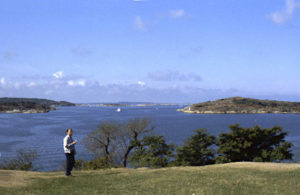
John on the waterfront. We are back in Sweden, in Strömstad, the first city you get to from Norway on the Swedish west coast.
After our brief stop in Oslo on our way back to Sweden, we continued southeast to Strömstad. This is Bohuslän, one of my favorite regions in Sweden.
We spent a couple of summers there when I was in my teens and I feel that I know it fairly well, having made little excursions north and south from Hamburgsund, where we were staying.
‘Our’ Bohuslän is about forty kilometers south of Strömstad. There the islands are barren, and they in no way resemble the green archipelago of Stockholm.
Waves hit the rocks hard and continuously, the mighty rocks in the west next to the small fishing boat harbors. The heavy breakers make a constant soothing background music as they break against the rocks. We got used to going to sleep to the sound of this monotonous and wonderful breakers from Mother Nature.
From Bohuslän we headed south to Lund again, where sister Gun was waiting with a crayfish supper. We were very sadly surprised that the government liquor store in Strömstad was closed on Saturdays. In Norway there are so few liquor stores that we were told there was none at all between Oslo and Bergen on the west coast. We had been in Voss on a Saturday and a Sunday. In the evening after our second pretty long walk we decided we wanted snaps with dinner. No way. No liquor at all in restaurants on Sundays in Norway. Oh well. We survived. In Lund too, I believe Gun managed to come up with something to replace the snaps we didn’t bring.
And so went the memorable visit to Scandinavia by my parents-in-law. Even though the perfectly incredible heat in Stockholm made that visit pretty much a downpoint, I do think that the entire trip was a big success — thanks to the wonderful reception by Gun, Per and family. Thank you dear Gun, thank you dear Per. Thank you all.
Continued: Chapter 30 – Travels from Paris – London
